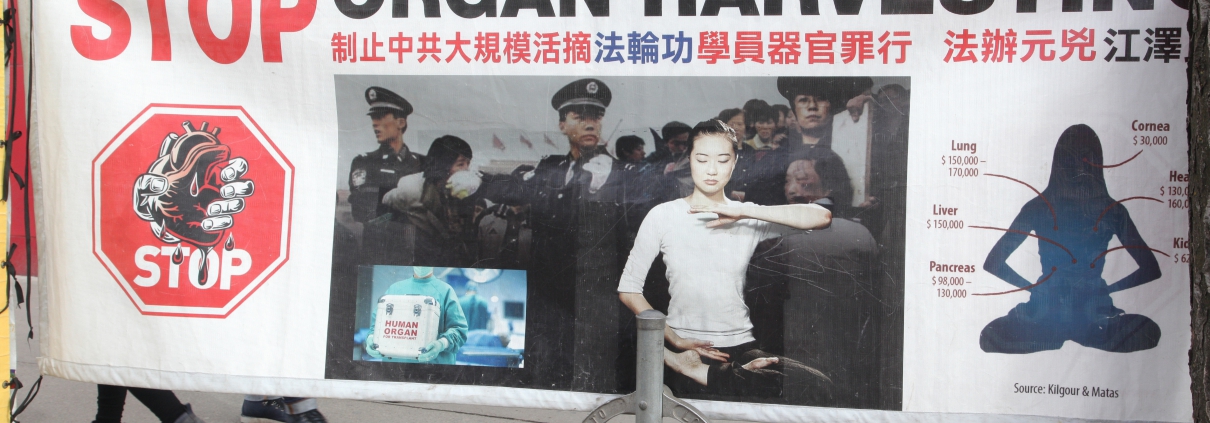The Chinese Communist Party treats the question of transplant volume as a state secret. But evidence is emerging that suggests China’s ready supply of organs is related to the dwindling number of government dissenters.By Murray Bessette • March 11, 2020 https://www.amgreatness.com/2020/03/11/evidence-china-executes-political-prisoners-to-harvest-organs/?fbclid=IwAR1Dv4VJ8fV-ov0myX9dueJBcwPZ3JkLb35hL-Rijuh2MhpSgeoziC2N-Vw
hina’s organ transplantation system appears capable of working miracles. Need a new liver? You can get one in 24 to 72 hours—for a price. To anyone familiar with the voluntary organ donation system in the United States, where the median wait time for a liver exceeds 300 days, such availability raises the question about organ sourcing.
How does the Chinese system locate, identify, and match a deceased donor within such a short timeframe?00:00
The Victims of Communism Memorial Foundation (VOC) on Tuesday released “Organ Procurement and Extrajudicial Execution in China: A Review of the Evidence,” a report by China Studies Research Fellow Matthew P. Robertson that examines the evidence underlying allegations of extrajudicial killing for the harvesting of organs by the Chinese Communist Party (CCP).
The report, together with the final judgment of the China Tribunal charged with investigating the question of the criminal liability of the Chinese state with respect to forced organ harvesting from prisoners of conscience, challenges international complacency on the topic.
The World Health Organization and the International Transplant Society simply accept the assertion of the CCP that the Chinese organ transplant system is both ethical and voluntary. World governments do not publicly challenge China as to the source of its organs, and international medical and human rights organizations fail to raise public concerns as to the scale of the PRC transplant system and the real source of organs.
Given the evidence of ongoing organ trafficking, the falsification of official datasets, and the signs that Uyghur Muslims may be the latest victims of this form of state predation, the necessity of coordinated, international action is clear.
Robertson found that starting in 2000, China rapidly constructed a world-class organ transplantation system that began performing tens of thousands of transplants annually.
At first, Chinese officials claimed that all organs were from voluntary civilian donors. When this claim became untenable, they stated that organs, in fact, were harvested from death-row prisoners.
The claim that even the majority of organs could have come from death row prisoners is contradicted by the well-established decline in death-row executions from 2000 onward.
A close examination of Chinese transplant activity indicates that hospitals have been performing at least several times more transplants than even the largest estimates of death-row prisoners. Given this, Robertson provisionally concludes that the Chinese had some other organ source apart from death-row inmates.
Robertson also found the number of emergency liver transplants (that is, transplants performed within 24–72 hours of a patient’s presentation at a hospital with liver failure) or on an “on-demand” basis (within days or weeks) expanded significantly post-2000. This is an extremely strong indication of a blood-typed pool of living donors able to be executed on demand.
If death row prisoners were not the source of the majority of transplants, Robertson contends the only remaining plausible explanation for a substantial portion of the organ sourcing since 2000 is prisoners of conscience.
China’s anti-Falun Gong campaign in July 1999 coincided with the rapid growth of China’s transplant industry six months later. Widely reported blood tests and physical examinations consistent with those required for organ procurement, telephone admissions by Chinese doctors, threats of organ harvesting by prison and labor camp guards, and participation in the anti-Falun Gong campaign by Chinese transplant surgeons all serve as evidence supporting this conclusion.
Since 2015 and due to international pressure, China’s organ transplantation system has claimed to source organs from voluntary donors only. Forensic analysis of the relevant data shows that it has been falsified. This appears to have been a deliberate attempt to deceive the international medical community as to the current source of organs in China. Given that transplants continue both at scale and on-demand, it appears that a secondary concealed organ source is currently also being exploited.
During the same period, the Chinese Communist Party has embarked upon a large-scale campaign against Uyghur Muslims. Part of this campaign has included blood-testing, DNA typing, and the reported shipment of Uyghurs from Xinjiang to the Chinese interior by rail. Former Uyghur detainees now in exile have reported blood tests and physical examinations consistent with those necessary to establish organ health.
The coincidence of the mass internment in Xinjiang, on-going rapid organ availability in Chinese hospitals, and blood and physical tests consistent with assessing organ health, is readily explicable by the exploitation of Uyghurs for their organs.
Chinese officials treat the question of transplant volume as a state secret. When asked about it, they deflect and obfuscate. At this stage, only the CCP is in a position to put these allegations to rest.
If the allegations of systematic state-sanctioned and supported murder for the purposes of selling organs are vicious slanders, one would expect the CCP to be transparent in demonstrating the legitimate and ethical source of transplanted organs. Instead, they have co-opted international medical elites, responded with propaganda to those making the allegations, and engaged in an elaborate scheme of data falsification, creating a Potemkin voluntary donation system while continuing to offer organs on-demand to paying clients.
In short, they behave like people with something to hide.
VOC published this report to bring attention to and careful consideration of these longstanding allegations, and to prompt not only a shift in the terms of debate on this issue but long-overdue American and international governmental investigation and action.
The price of a Chinese transplant is not paid in dollars and cents, but rather in the lives of the prisoners of conscience whose organs are harvested. The price is too high.

